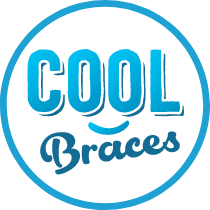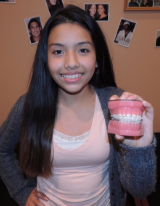Types of Orthodontic Appliances

Your personalized treatment plan may include any of these orthodontic appliances to achieve life-changing results from braces or Invisalign® treatment.
What do orthodontic appliances do?
Orthodontic appliances have a variety of uses. They’re effective for facilitating more efficient tooth movement, holding space in the mouth for permanent teeth to grow, and/or helping to support proper growth and development of the jaw bones.

Forsus™
The Forsus™ Fatigue Resistant Device, treats overbites by promoting a healthy alignment between the upper and lower teeth.
This appliance uses springs to apply persistent pressure on the upper and lower teeth and create resistance, shifting the upper teeth backward and the lower teeth forward. Once the appliance is in place, it shouldn’t require any maintenance until it’s removed. It’s important that you keep this appliance as clean as possible.
Palatal Expander
Palatal expanders are a common appliance used in early orthodontic treatment for children whose jaw bones are still developing. These appliances serve to widen the upper jaw to create the necessary space for teeth to erupt in a healthy alignment. Palatal expanders can help prevent crowding and impaction by guiding proper development of the jaw bone.
The rapid palatal expander (the most common type of palatal expander) is bonded to the upper molars on both sides of the top jaw, with a screw located in the center of the appliance. To activate the palatal expander, you’ll insert a special key to turn the center screw, which expands the device ever so slightly and widens the palate gradually over time.
If your child requires a palatal expander, we’ll tell you everything you need to know about cleaning it, activating it and caring for it.
TADs
Temporary anchorage devices (TADs) are temporary dental implants embedded into the bone to create an “anchor” that assists with tooth movement. These appliances are generally used when certain teeth require shifting, and others don’t. TADs enable us to treat individual teeth with greater efficiency.
These anchorage devices appear as tiny metal buttons, strategically implanted into an area of the jaw bone. A small wire or elastic may be attached to the TAD to connect it with the specific tooth (or teeth) in need of treatment.

Teeth Separators or Spacers
Spacers, also called separators, are small rubber bands that help to create the space necessary for braces to be placed. With braces, a metal band is placed around the back molars to anchor the arch wires in place. In cases where the molars are too close together to allow these metal bands to be placed, separators may be used.
Separators are temporary appliances that are only worn for about one to two weeks before active treatment begins.

Nance Appliance
The Nance appliance is used to hold the upper molars in place, to prevent them from rotating or shifting forward. With this appliance, two metal bands are cemented around the first molars and a wire connects the back molars to an acrylic pad, located behind the two front teeth.
Reverse-Pull Headgear (Orthodontic Facemask)
The reverse-pull headgear (facemask) is an incredibly effective appliance used to promote proper alignment of the jaw bones for young kids. It works by pulling the upper jaw forward. This appliance treats underbite conditions that may otherwise require jaw surgery to correct. This appliance can be incredibly helpful for young patients, ages 7-10.


Banded Bite Plate
A banded bite plate serves to correct a deep bite (overbite) condition. This appliance fits behind the upper, front teeth, and disables the rear teeth from meeting when the mouth is closed, which allows these posterior teeth to develop properly. Over several months, the deep bite will become corrected!
Lower Lingual Arch (Space Maintainer)
The lower lingual holding arch is a space maintainer that uses metal bands around the two lower molars, with a metal wire spanning from the molars, around the inside of the bottom teeth. Used to hold the necessary space in the mouth for premolars to grow, the lower lingual arch appliance establishes the proper foundation that shapes the lower arch in a healthy alignment.
Quad-Helix Appliance
Quad-Helix Appliances widen the upper jaw with metal bands around the top molars and active helix springs lining the arch. These appliances are usually fixed, and they are effective for treating crossbites and crowding.


Pendulum Appliance/Distal Jet
The Pendulum Appliance and Distal Jet is hidden in the roof of the mouth and used to shift the molar teeth to create the necessary room for other teeth to erupt in alignment. This appliance treats crowding and various bite misalignments by using metal bands around the back molars, wires bonded to the middle teeth, and an acrylic plate that rests behind the front teeth.

Ready?
Your smile is a work of art. Let’s make you a magnet for life’s opportunities.
All you have to do is start the convo, and we’ll take it from there.






